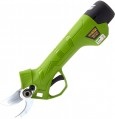The largest diameter (thickness) of a branch that the tool can handle.
The larger the maximum cut diameter, the more powerful this model, the lower the likelihood that a certain branch will be too tough for the tool. At the same time, note that to ensure high power, long handles and strong blades are needed, which accordingly affects the dimensions, weight and price. Therefore, it is worth choosing according to this parameter with a certain margin, but at the same time, this margin should not be too large.
As for specific figures, a maximum diameter
of 20 mm or less is considered relatively small, but it often turns out to be quite enough for simple work.
21 – 30 mm — the average value,
31 – 40 mm — above average, and in loppers the maximum thickness can
exceed 40 mm.
The operating voltage of the battery installed in the tool of the corresponding type (see above).
The higher the power, the higher the voltage may be required (but not necessarily required) to power it efficiently. In other words, a high battery voltage is usually indicative of advanced performance, while a low battery voltage is not always a sign of an entry-level tool. On the practical side, this parameter can only be useful for some specific tasks — for example, looking for an external charger for a battery or buying a spare battery. In addition, this parameter must be taken into account when comparing different batteries in terms of capacity (for more details, see "Battery Capacity").
